Large-Scale Piezoelectric-Based Systems for More Electric Aircraft Applications
Abstract
1. Introduction
2. Piezoelectric Actuators
2.1. Fundamentals of Piezoelectric Materials
2.2. Piezoelectric Stacks
2.3. Classification of Amplification Methods
3. Continuous Motion
3.1. Compliant Mechanism
3.2. Piezoelectric Bending
4. Quasi-Static Stepped Motion
4.1. Inertial Concept
4.2. Inchworm Concept
4.3. Walking Concept
5. Ultrasonic Stepped Motion
6. Hybrid Piezoelectric–Hydraulic System
6.1. Design of the Piezoelectric Configuration
6.2. Design of the Pump Chamber
6.3. Design of the Valve System
7. Piezoelectric-Based Systems in Aerospace Applications
8. Conclusions
Author Contributions
Funding
Acknowledgments
Conflicts of Interest
References
- Rubertus, D.P.; Hunter, L.D.; Cecere, G.J. Electromechanical Actuation Technology for the All-Electric Aircraft. IEEE Trans. Aerosp. Electron. Syst. 1984, AES-20, 243–249. [Google Scholar] [CrossRef]
- Rosero, J.A.; Ortega, J.A.; Aldabas, E.; Romeral, L. Moving towards a more electric aircraft. IEEE. Aerosp. Electron. Syst. Mag. 2007, 22, 3–9. [Google Scholar] [CrossRef]
- Qiao, G.; Liu, G.; Shi, Z.; Wang, Y.; Ma, S.; Lim, T.C. A review of electromechanical actuators for More/All Electric aircraft systems. Proc. Inst. Mech. Eng. Part C J. Mech. Eng. Sci. 2017, 232, 4128–4151. [Google Scholar] [CrossRef]
- MarÉ, J.-C.; Fu, J. Review on signal-by-wire and power-by-wire actuation for more electric aircraft. Chin. J. Aeronaut. 2017, 30, 857–870. [Google Scholar] [CrossRef]
- Viswanathan, V.; Knapp, B.M. Potential for electric aircraft. Nat. Sustain. 2019, 2, 88–89. [Google Scholar] [CrossRef]
- Cecati, C.; Song, S.; Buticchi, G. Special Issue on More Electric Aircraft. IEEE Trans. Transp. Electrif. 2020, 6, 1382–1385. [Google Scholar] [CrossRef]
- Emmanouil, K. Reliability in the era of electrification in aviation: A systems approach. Microelectron. Reliab. 2020, 114, 113945. [Google Scholar] [CrossRef]
- Zaporozhets, O.; Isaienko, V.; Synylo, K. Trends on current and forecasted aircraft hybrid electric architectures and their impact on environment. Energy 2020, 211, 118814. [Google Scholar] [CrossRef]
- Janker, P.; Claeyssen, F.; Grohmann, B.; Christmann, M.; Lorkowski, T.; LeLetty, R.; Sosniki, O.; Pages, A. New actuators for aircraft and space applications. In Proceedings of the 11th International Conference on New Actuators, Bremen, Germany, 9–11 June 2008; pp. 325–330. [Google Scholar]
- Todeschi, M. Airbus—EMAs for Flight Controls Actuation System—An Important Step Achieved in 2011; SAR Technical Papers; SAE International: Warrendale, PA, USA, 2011; Volume 1. [Google Scholar] [CrossRef]
- Jensen, S.C.; Jenney, G.D.; Dawson, D. Flight test experience with an electromechanical actuator on the F-18 Systems Research Aircraft. In Proceedings of the 19th DASC. 19th Digital Avionics Systems Conference; Proceedings (Cat. No.00CH37126), Philadelphia, PA, USA, 7–13 October 2000; Volume 311, pp. 2E3/1–2E3/10. [Google Scholar] [CrossRef]
- Newman, R. The More Electric Engine Concept. SAE Trans. 2004, 113, 1656–1661. [Google Scholar] [CrossRef]
- Bennett, J.W.; Mecrow, B.C.; Jack, A.G.; Atkinson, D.J. A Prototype Electrical Actuator for Aircraft Flaps. IEEE Trans. Ind. Appl. 2010, 46, 915–921. [Google Scholar] [CrossRef]
- Cao, W.; Mecrow, B.C.; Atkinson, G.J.; Bennett, J.W.; Atkinson, D.J. Overview of Electric Motor Technologies Used for More Electric Aircraft (MEA). IEEE Trans. Ind. Electron. 2012, 59, 3523–3531. [Google Scholar] [CrossRef]
- Budinger, M.; Liscouët, J.; Hospital, F.; Maré, J.C. Estimation models for the preliminary design of electromechanical actuators. Proc. Inst. Mech. Eng. Part G J. Aerosp. Eng. 2011, 226, 243–259. [Google Scholar] [CrossRef]
- Fu, J.; Maré, J.-C.; Fu, Y. Modelling and simulation of flight control electromechanical actuators with special focus on model architecting, multidisciplinary effects and power flows. Chin. J. Aeronaut. 2017, 30, 47–65. [Google Scholar] [CrossRef]
- Giangrande, P.; Galassini, A.; Papadopoulos, S.; Al-Timimy, A.; Calzo, G.L.; Degano, M.; Galea, M.; Gerada, C. Considerations on the Development of an Electric Drive for a Secondary Flight Control Electromechanical Actuator. IEEE Trans. Ind. Appl. 2019, 55, 3544–3554. [Google Scholar] [CrossRef]
- Moir, I.; Seabridge, A.G. Aircraft Systems: Mechanical, Electrical, and Avionics Subsystems Integration, 3rd ed.; Wiley: Chichester, UK, 2008. [Google Scholar] [CrossRef]
- Ismagilov, F.R.; Vavilov, V.E.; Sayakhov, I.F. Mathematical model of an aircraft electromechanical actuator with flex coupling. In Proceedings of the 2017 Dynamics of Systems, Mechanisms and Machines (Dynamics), Omsk, Russia, 14–16 November 2017; pp. 1–5. [Google Scholar] [CrossRef]
- Panda, P.K.; Sahoo, B. PZT to Lead Free Piezo Ceramics: A Review. Ferroelectrics 2015, 474, 128–143. [Google Scholar] [CrossRef]
- Sun, L.; Huang, W.M.; Ding, Z.; Zhao, Y.; Wang, C.C.; Purnawali, H.; Tang, C. Stimulus-responsive shape memory materials: A review. Mater. Des. 2012, 33, 577–640. [Google Scholar] [CrossRef]
- Apicella, V.; Clemente, C.S.; Davino, D.; Leone, D.; Visone, C. Review of Modeling and Control of Magnetostrictive Actuators. Actuators 2019, 8, 45. [Google Scholar] [CrossRef]
- Bar-Cohen, Y. Electroactive polymers as artificial muscles-Reality and challenges. In Proceedings of the 19th AIAA Applied Aerodynamics Conference, Anaheim, CA, USA, 11–14 June 2001; p. 1492. [Google Scholar] [CrossRef]
- Bashir, M.; Rajendran, P. A review on electroactive polymers development for aerospace applications. J. Intell. Mater. Syst. Struct. 2018, 29, 3681–3695. [Google Scholar] [CrossRef]
- Crawley, E.F. Intelligent structures for aerospace—A technology overview and assessment. AIAA J. 1994, 32, 1689–1699. [Google Scholar] [CrossRef]
- Basheer, A.A. Advances in the smart materials applications in the aerospace industries. Aircr. Eng. Aerosp. Technol. 2020, 92. [Google Scholar] [CrossRef]
- Sun, J.; Guan, Q.; Liu, Y.; Leng, J. Morphing aircraft based on smart materials and structures: A state-of-the-art review. J. Intell. Mater. Syst. Struct. 2016, 27, 2289–2312. [Google Scholar] [CrossRef]
- Grohmann, B.; Maucher, C.; Jänker, P. Actuation concepts for morphing helicopter rotor blades. In Proceedings of the 25th International Congress of the Aeronautical Sciences, Hamburg, Germany, 3–8 September 2006. [Google Scholar]
- Calkins, F.; Butler, G.; Mabe, J. Variable Geometry Chevrons for Jet Noise Reduction. In Proceedings of the 12th AIAA/CEAS Aeroacoustics Conference (27th AIAA Aeroacoustics Conference), Cambridge, MA, USA, 8–10 May 2006. [Google Scholar] [CrossRef]
- Calkins, F.T.; Mabe, J.H. Shape Memory Alloy Based Morphing Aerostructures. J. Mech. Des. 2010, 132. [Google Scholar] [CrossRef]
- Jaenker, P.; Kloeppel, V.; Konstanzer, P.; Maier, R. Piezo active vibration and noise control in helicopters. In Proceedings of the 26th Congress of International Council of the Aeronautical Sciences, Anchorage, AK, USA, 14–19 September 2008; pp. 1–10. [Google Scholar]
- Loewy, R.G. Recent developments in smart structures with aeronautical applications. Smart Mater. Struct. 1997, 6, R11–R42. [Google Scholar] [CrossRef]
- Philippe, B.; Frank, C.; Ronan Le, L. Amplified piezoelectric actuators: From aerospace to underwater applications. In Proceedings of the SPIE 5388, Smart Structures and Materials 2004: Industrial and Commercial Applications of Smart Structures Technologies, San Diego, CA, USA, 29 July 2004. [Google Scholar] [CrossRef]
- Sherrit, S. Smart material/actuator needs in extreme environments in space. In Proceedings of the SPIE 5761, Smart Structures and Materials 2005: Active Materials: Behavior and Mechanics, San Diego, CA, USA, 16 May 2005. [Google Scholar] [CrossRef]
- Uchino, K. Piezoelectric actuators 2006. J. Electroceram. 2008, 20, 301–311. [Google Scholar] [CrossRef]
- Elahi, H.; Munir, K.; Eugeni, M.; Abrar, M.; Khan, A.; Arshad, A.; Gaudenzi, P. A Review on Applications of Piezoelectric Materials in Aerospace Industry. Integr. Ferroelectr. 2020, 211, 25–44. [Google Scholar] [CrossRef]
- Lagomarsini, C.; Jean-Mistral, C.; Lombardi, G.; Sylvestre, A. Hybrid piezoelectric–electrostatic generators for wearable energy harvesting applications. Smart Mater. Struct. 2019, 28, 035003. [Google Scholar] [CrossRef]
- Jiao, P.; Egbe, K.-J.I.; Xie, Y.; Matin Nazar, A.; Alavi, A.H. Piezoelectric Sensing Techniques in Structural Health Monitoring: A State-of-the-Art Review. Sensors 2020, 20, 3730. [Google Scholar] [CrossRef]
- Wang, S.; Rong, W.; Wang, L.; Xie, H.; Sun, L.; Mills, J.K. A survey of piezoelectric actuators with long working stroke in recent years: Classifications, principles, connections and distinctions. Mech. Syst. Signal. Process. 2019, 123, 591–605. [Google Scholar] [CrossRef]
- Huber, J.; Fleck, N.; Ashby, M. The selection of mechanical actuators based on performance indices. Proc. Math. Phys. Eng. Sci. 1997, 453, 2185–2205. [Google Scholar] [CrossRef]
- Xiaoning, J.; Paul, W.R.; Wesley, S.H.; Edward, S.; Shuxiang, D.; Dwight, V.; Jim, M., Jr.; Brian, P. Advanced piezoelectric single crystal based actuators. In Proceedings of the SPIE 5761, Smart Structures and Materials 2005: Active Materials: Behavior and Mechanics, San Diego, CA, USA, 16 May 2005. [Google Scholar] [CrossRef]
- Dong, S. Review on piezoelectric, ultrasonic, and magnetoelectric actuators. J. Adv. Dielectr. 2012, 2, 1230001. [Google Scholar] [CrossRef]
- Zupan, M.; Ashby, M.F.; Fleck, N.A. Actuator Classification and Selection—The Development of a Database. Adv. Eng. Mater. 2002, 4, 933–940. [Google Scholar] [CrossRef]
- Hooker, M.W. Properties of PZT-Based Piezoelectric Ceramics between −150 and 250 °C; NASA/CR-1998-208708; Langley Research Center: Hampton, VA, USA, 1998. [Google Scholar]
- Stevenson, T.; Martin, D.G.; Cowin, P.I.; Blumfield, A.; Bell, A.J.; Comyn, T.P.; Weaver, P.M. Piezoelectric materials for high temperature transducers and actuators. J. Mater. Sci. Mater. Electron. 2015, 26, 9256–9267. [Google Scholar] [CrossRef]
- Huang, S.; Zeng, J.; Zheng, L.; Man, Z.; Ruan, X.; Shi, X.; Li, G. A novel piezoelectric ceramic with high Curie temperature and high piezoelectric coefficient. Ceram. Int. 2020, 46, 6212–6216. [Google Scholar] [CrossRef]
- Rusovici, R.; Choon, S.T.-C.K.; Sepri, P.; Feys, J. Smart actuation of inlet guide vanes for small turbine engine. In Proceedings of the SPIE 7981, Sensors and Smart Structures Technologies for Civil, Mechanical, and Aerospace Systems 2011, San Diego, CA, USA, 15 April 2011; p. 79813F. [Google Scholar] [CrossRef]
- Rusovici, R. Apparatus and Method for Rotating Fluid Controlling Vanes in Small Turbine Engines and Other Applications. U.S. Patent US9,394,804B2, 19 July 2016. [Google Scholar]
- Vonfelt, J.-J.C.; Klonowski, T.; Moutaux, A. A Device for Controlling Inlet Guide Vanes by Means of a Multilayer Piezoelectric Actuator. U.S. Patent US10,731,504B2, 4 August 2020. [Google Scholar]
- Erturk, A.; Inman, D.J. Piezoelectric Energy Harvesting; John Wiley & Sons: Chichester, UK, 2011; p. 412. [Google Scholar]
- Craig, D.N. Piezoelectric actuator technology. In Proceedings of the SPIE 2717, Smart Structures and Materials 1996: Smart Structures and Integrated Systems, San Diego, CA, USA, 1 May 1996. [Google Scholar] [CrossRef]
- Shafik, A.; Ben Mrad, R. Piezoelectric Motor Technology: A Review. In Nanopositioning Technologies: Fundamentals and Applications; Ru, C., Liu, X., Sun, Y., Eds.; Springer: Cham, Switzerland, 2016; pp. 33–59. [Google Scholar] [CrossRef]
- Saito, Y.; Takao, H.; Tani, T.; Nonoyama, T.; Takatori, K.; Homma, T.; Nagaya, T.; Nakamura, M. Lead-free piezoceramics. Nature 2004, 432, 84–87. [Google Scholar] [CrossRef] [PubMed]
- Shrout, T.R.; Zhang, S.J. Lead-free piezoelectric ceramics: Alternatives for PZT? J. Electroceram. 2007, 19, 113–126. [Google Scholar] [CrossRef]
- Khesro, A.; Wang, D.; Hussain, F.; Sinclair, D.C.; Feteira, A.; Reaney, I.M. Temperature stable and fatigue resistant lead-free ceramics for actuators. Appl. Phys. Lett. 2016, 109, 142907. [Google Scholar] [CrossRef]
- Takenaka, T.; Nagata, H. Current status and prospects of lead-free piezoelectric ceramics. J. Eur. Ceram. Soc. 2005, 25, 2693–2700. [Google Scholar] [CrossRef]
- Ringgaard, E.; Wurlitzer, T.; Wolny, W.W. Properties of Lead-Free Piezoceramics Based on Alkali Niobates. Ferroelectrics 2005, 319, 97–107. [Google Scholar] [CrossRef]
- Poole, A.; Booker, J.D. Classification and selection of actuator technologies with consideration of stimuli generation. In Proceedings of the SPIE 6927, Electroactive Polymer Actuators and Devices (EAPAD) 2008, San Diego, CA, USA, 10 April 2008; p. 692728. [Google Scholar] [CrossRef]
- Hassani, V.; Tjahjowidodo, T. A hysteresis model for a stacked-type piezoelectric actuator. Mech. Adv. Mater. Struct. 2017, 24, 73–87. [Google Scholar] [CrossRef]
- Benayad, A.; Sebald, G.; Guiffard, B.; Lebrun, L.; Guyomar, D.; Pleska, E. Temperature dependence of piezoelectric properties of PMN-PT and PZN-PT single crystals. J. Phys. IV 2005, 126, 53–57. [Google Scholar] [CrossRef]
- Suo, Z.; Kuo, C.M.; Barnett, D.M.; Willis, J.R. Fracture mechanics for piezoelectric ceramics. J. Mech. Phys. Solid 1992, 40, 739–765. [Google Scholar] [CrossRef]
- Yano, T.; Takahashi, S. Utilization of piezoelectric stiffened effects on impact printer heads. Electron. Commun. Jpn. Part II Electron. 1989, 72, 19–32. [Google Scholar] [CrossRef]
- Hollerbach, J.M.; Hunter, I.W.; Ballantyne, J. A comparative analysis of actuator technologies for robotics. In The Robotics Review 2; Khatib, O., Craig, J.J., Lozano-Perez, T., Eds.; MIT Press: Cambridge, MA, USA, 1991; Volume 2, pp. 299–342. [Google Scholar]
- Hana, P.; Burianova, L.; Furman, E.; Cross, L.E. Dielectric Properties of PZN-PT Single Crystals Influenced by Electric Field in a Wide Temperature Range. Ferroelectrics 2003, 293, 321–330. [Google Scholar] [CrossRef]
- Piezoelectric Materials. Available online: https://www.physikinstrumente.com/en/technology/piezo-technology/piezoelectric-materials/#c15163 (accessed on 28 July 2020).
- Wilkie, W.; High, J.; Bockman, J. Reliability Testing of NASA Piezocomposite Actuators. 2002. Available online: https://ntrs.nasa.gov/citations/20030014135 (accessed on 15 January 2021).
- Wilkie, W. NASA MFC piezocomposites: A development history. In Proceedings of the International Symposium on Macro Fiber Composite Applications ISMA, Volkswagen “Transparent Factory”, Dresden, Germany, 27–28 September 2005. [Google Scholar]
- Macro Fiber Composite Actuator & Sensor. Available online: https://www.smart-material.com/MFC-product-main.html (accessed on 12 January 2020).
- Andreas, J.S.; Thomas, D.; Bent, B.; Christian, F.; Ludwig, H.; Thomas, R. Overview on macrofiber composite applications. In Proceedings of the SPIE 6170, Smart Structures and Materials 2006: Active Materials: Behavior and Mechanics, San Diego, CA, USA, 6 April 2006. [Google Scholar] [CrossRef]
- Macro Fiber Composite Generators. Available online: https://www.smart-material.com/EH-MFC-generators.html (accessed on 12 January 2020).
- Thomas, P.R.; Blázquez Calzada, Á.C.; Gilmour, K. Modeling of macro fiber composite actuated laminate plates and aerofoils. J. Intell. Mater. Syst. Struct. 2019, 31, 525–549. [Google Scholar] [CrossRef]
- Lee, H.J.; Zhang, S.; Bar-Cohen, Y.; Sherrit, S. High Temperature, High Power Piezoelectric Composite Transducers. Sensors 2014, 14, 14526–14552. [Google Scholar] [CrossRef]
- Anderson, E.; Moore, D.; Fanson, J.; Ealey, M. Development of an active member using piezoelectric and electrostrictive actuation for control of precision structures. In Proceedings of the 31st Structures, Structural Dynamics and Materials Conference, Long Beach, CA, USA, 2–4 April 1990. [Google Scholar] [CrossRef]
- Straub, F.K.; Merkley, D.J. Design of a smart material actuator for rotor control. Smart Mater. Struct. 1997, 6, 223–234. [Google Scholar] [CrossRef]
- Ru, C.; Sun, L. Improving positioning accuracy of piezoelectric actuators by feedforward hysteresis compensation based on a new mathematical model. Rev. Sci. Instrum. 2005, 76, 095111. [Google Scholar] [CrossRef]
- Amplified Piezo Actuators. Available online: https://www.cedrat-technologies.com/en/products/actuators/amplified-piezo-actuators.html (accessed on 28 July 2020).
- Claeyssen, F.; Letty, R.L.; Barillot, F.; Sosnicki, O. Amplified Piezoelectric Actuators: Static & Dynamic Applications. Ferroelectrics 2007, 351, 3–14. [Google Scholar] [CrossRef]
- Zhou, C.; Li, J.; Duan, J.; Deng, G. Direct-Acting Piezoelectric Jet Dispenser with Rhombic Mechanical Amplifier. IEEE Trans. Compon. Packag. Manuf. Technol. 2018, 8, 910–913. [Google Scholar] [CrossRef]
- Hricko, J.; Havlík, Š. Compliant Mechanisms for Motion/Force Amplifiers for Robotics. In Advances in Service and Industrial Robotics; Berns, K., Görges, D., Eds.; Springer: Cham, Switzerland, 2019; Volume 980, pp. 26–33. [Google Scholar]
- Shao, S.B.; Xu, M.L.; Chen, J.; Feng, B. Optimal design of the large stroke piezoelectric actuator using rhombic mechanism. In Recent Advances in Structural Integrity Analysis—Proceedings of the International Congress (APCF/SIF-2014); Ye, L., Ed.; Woodhead Publishing: Oxford, UK, 2014; pp. 442–446. [Google Scholar] [CrossRef]
- Wei, H.; Shirinzadeh, B.; Li, W.; Clark, L.; Pinskier, J.; Wang, Y. Development of Piezo-Driven Compliant Bridge Mechanisms: General Analytical Equations and Optimization of Displacement Amplification. Micromachines 2017, 8, 238. [Google Scholar] [CrossRef]
- Chen, J.; Zhang, C.; Xu, M.; Zi, Y.; Zhang, X. Rhombic micro-displacement amplifier for piezoelectric actuator and its linear and hybrid model. Mech. Syst. Signal. Process. 2015, 50–51, 580–593. [Google Scholar] [CrossRef]
- Chen, C.-M.; Hsu, Y.-C.; Fung, R.-F. System identification of a Scott–Russell amplifying mechanism with offset driven by a piezoelectric actuator. Appl. Math. Modell. 2012, 36, 2788–2802. [Google Scholar] [CrossRef]
- Chen, W.; Zhang, X.; Li, H.; Wei, J.; Fatikow, S. Nonlinear analysis and optimal design of a novel piezoelectric-driven compliant microgripper. Mech. Mach. Theory 2017, 118, 32–52. [Google Scholar] [CrossRef]
- Muraoka, M.; Sanada, S. Displacement amplifier for piezoelectric actuator based on honeycomb link mechanism. Sens. Actuator A Phys. 2010, 157, 84–90. [Google Scholar] [CrossRef]
- Ham, Y.-B.; Seo, W.-S.; Cho, W.-Y.; Yun, D.-W.; Park, J.-H.; Yun, S.-N. Development of a piezoelectric pump using hinge-lever amplification mechanism. J. Electroceram. 2008, 23, 346. [Google Scholar] [CrossRef]
- Lee, J.-W.; Li, Y.-C.; Chen, K.-S.; Liu, Y.-H. Design and control of a cascaded piezoelectric actuated two-degrees-of-freedom positioning compliant stage. Precis. Eng. 2016, 45, 374–386. [Google Scholar] [CrossRef]
- Tzianetopoulou, T. Design of an Improved Piezoelectric Actuator for Helicopter Rotor Control. Master’s Thesis, Massachusetts Institute of Technology, Cambridge, MA, USA, 2001. [Google Scholar]
- Huang, Y.; Xia, Y.X.; Lin, D.H.; Lim, L.-C. High-Bending-Stiffness Connector (HBSC) and High-Authority Piezoelectric Actuator (HAPA) Made of Such. Actuators 2018, 7, 61. [Google Scholar] [CrossRef]
- Vaughan, M.; Leo, D.J. Integrated Piezoelectric Linear Motor for Vehicle Applications. In Proceedings of the ASME 2002 International Mechanical Engineering Congress and Exposition. Transportation: Making Tracks for Tomorrow’s Transportation, New Orleans, LA, USA, 17–22 November 2002; pp. 113–121. [Google Scholar] [CrossRef]
- Li, J.; Zhao, H.; Qu, X.; Qu, H.; Zhou, X.; Fan, Z.; Ma, Z.; Fu, H. Development of a compact 2-DOF precision piezoelectric positioning platform based on inchworm principle. Sens. Actuator A Phys. 2015, 222, 87–95. [Google Scholar] [CrossRef]
- Cheng, T.; He, M.; Li, H.; Lu, X.; Zhao, H.; Gao, H. A Novel Trapezoid-Type Stick–Slip Piezoelectric Linear Actuator Using Right Circular Flexure Hinge Mechanism. IEEE Trans. Ind. Electron. 2017, 64, 5545–5552. [Google Scholar] [CrossRef]
- Gao, Q.; He, M.; Lu, X.; Zhang, C.; Cheng, T. Simple and high-performance stick-slip piezoelectric actuator based on an asymmetrical flexure hinge driving mechanism. J. Intell. Mater. Syst. Struct. 2019, 30, 2125–2134. [Google Scholar] [CrossRef]
- Huang, W.; Sun, M. Design, Analysis, and Experiment on a Novel Stick-Slip Piezoelectric Actuator with a Lever Mechanism. Micromachines 2019, 10, 863. [Google Scholar] [CrossRef] [PubMed]
- Rios, S.A.; Fleming, A.J. Design of a Charge Drive for Reducing Hysteresis in a Piezoelectric Bimorph Actuator. IEEE ASME Trans. Mechatron. 2016, 21, 51–54. [Google Scholar] [CrossRef]
- Wang, H.; Hu, M.; Li, Z. Modelling and analysis of circular bimorph piezoelectric actuator for deformable mirror. Appl. Math. Mech. 2016, 37, 639–646. [Google Scholar] [CrossRef]
- Jayaram, K.; Jafferis, N.T.; Doshi, N.; Goldberg, B.; Wood, R.J. Concomitant sensing and actuation for piezoelectric microrobots. Smart Mater. Struct. 2018, 27, 065028. [Google Scholar] [CrossRef]
- Chen, K.; Wen, J.; Cheng, G.; Ma, J.; Zeng, P. An asymmetrical inertial piezoelectric rotary actuator with the bias unit. Sens. Actuator A Phys. 2016, 251, 179–187. [Google Scholar] [CrossRef]
- Chen, S.; Yu, M.; Kan, J.; Li, J.; Zhang, Z.; Xie, X.; Wang, X. A Dual-Chamber Serial-Parallel Piezoelectric Pump with an Integrated Sensor for Flow Rate Measurement. Sensors 2019, 19, 1447. [Google Scholar] [CrossRef]
- Hall, S.R.; Prechtl, E.F. Development of a piezoelectric servoflap for helicopter rotor control. Smart Mater. Struct. 1996, 5, 26–34. [Google Scholar] [CrossRef]
- Belly, C.; Charon, W. Benefits of amplification in an inertial stepping motor. Mechatronics 2012, 22, 177–183. [Google Scholar] [CrossRef]
- Zhang, Z.M.; An, Q.; Li, J.W.; Zhang, W.J. Piezoelectric friction–inertia actuator—A critical review and future perspective. Int. J. Adv. Manuf. Technol. 2012, 62, 669–685. [Google Scholar] [CrossRef]
- Li, J.; Zhao, H.; Shao, M.; Zhou, X.; Fan, Z. Design and experimental research of an improved stick–slip type piezo-driven linear actuator. Adv. Mech. Eng. 2015, 7, 1687814015595016. [Google Scholar] [CrossRef]
- Li, J.; Zhou, X.; Zhao, H.; Shao, M.; Li, N.; Zhang, S.; Du, Y. Development of a Novel Parasitic-Type Piezoelectric Actuator. IEEE ASME Trans. Mechatron. 2017, 22, 541–550. [Google Scholar] [CrossRef]
- Li, J.; Huang, H.; Zhao, H. A Piezoelectric-Driven Linear Actuator by Means of Coupling Motion. IEEE Trans. Ind. Electron. 2018, 65, 2458–2466. [Google Scholar] [CrossRef]
- Higuchi, T.; Yamagata, Y.; Furutani, K.; Kudoh, K. Precise positioning mechanism utilizing rapid deformations of piezoelectric elements. In Proceedings of the IEEE Proceedings on Micro Electro Mechanical Systems, An Investigation of Micro Structures, Sensors, Actuators, Machines and Robots, Napa Valley, CA, USA, 11–14 February 1990; pp. 222–226. [Google Scholar] [CrossRef]
- Li, J.; Zhou, X.; Zhao, H.; Shao, M.; Hou, P.; Xu, X. Design and experimental performances of a piezoelectric linear actuator by means of lateral motion. Smart Mater. Struct. 2015, 24, 065007. [Google Scholar] [CrossRef]
- Li, J.; Sedaghati, R.; Dargahi, J.; Waechter, D. Design and development of a new piezoelectric linear Inchworm® actuator. Mechatronics 2005, 15, 651–681. [Google Scholar] [CrossRef]
- Li, J.; Zhao, H.; Qu, H.; Cui, T.; Fu, L.; Huang, H.; Ren, L.; Fan, Z. A piezoelectric-driven rotary actuator by means of inchworm motion. Sens. Actuator A Phys. 2013, 194, 269–276. [Google Scholar] [CrossRef]
- Hua, S.; Liu, G.; Wang, X.; Wang, Y.; Li, J. A piezoelectric inchworm actuator with bidirectional thrust force. Sens. Transducers 2014, 171, 169. [Google Scholar]
- Wang, S.; Rong, W.; Wang, L.; Pei, Z.; Sun, L. A novel inchworm type piezoelectric rotary actuator with large output torque: Design, analysis and experimental performance. Precis. Eng. 2018, 51, 545–551. [Google Scholar] [CrossRef]
- Tian, X.; Zhang, B.; Liu, Y.; Chen, S.; Yu, H. A novel U-shaped stepping linear piezoelectric actuator with two driving feet and low motion coupling: Design, modeling and experiments. Mech. Syst. Signal. Process. 2019, 124, 679–695. [Google Scholar] [CrossRef]
- Gao, Y.; Wen, J.; Ma, J.; Zhang, Y.; Wang, R.; Hu, Y.; Li, J. A self-adapting linear inchworm piezoelectric actuator based on a permanent magnets clamping structure. Mech. Syst. Signal. Process. 2019, 132, 429–440. [Google Scholar] [CrossRef]
- Kim, J.; Kim, H.-K.; Choi, S.-B. A hybrid inchworm linear motor. Mechatronics 2002, 12, 525–542. [Google Scholar] [CrossRef]
- Kim, I.; Kim, Y.-S.; Park, E.-C. Sliding mode control of the inchworm displacement with hysteresis compensation. Int. J. Precis. Eng. Manuf. 2009, 10, 43–49. [Google Scholar] [CrossRef]
- Li, J.; Zhao, H.; Shao, M.; Zhou, X.; Huang, H.; Fan, Z. Design and experiment performances of an inchworm type rotary actuator. Rev. Sci. Instrum. 2014, 85, 085004. [Google Scholar] [CrossRef] [PubMed]
- Yan, S.; Zhang, F.; Qin, Z.; Wen, S. A 3-DOFs mobile robot driven by a piezoelectric actuator. Smart Mater. Struct. 2005, 15, N7–N13. [Google Scholar] [CrossRef]
- Wen, J.; Ma, J.; Zeng, P.; Cheng, G.; Zhang, Z. A new inertial piezoelectric rotary actuator based on changing the normal pressure. Microsyst. Technol. 2013, 19, 277–283. [Google Scholar] [CrossRef]
- Shen, D.; Wen, J.; Ma, J.; Hu, Y.; Wang, R.; Li, J. A novel linear inertial piezoelectric actuator based on asymmetric clamping materials. Sens. Actuator A Phys. 2020, 303, 111746. [Google Scholar] [CrossRef]
- Wang, S.; Zhang, Z.; Ren, L.; Zhao, H.; Liang, Y.; Zhu, B. Design and driving characteristics of a novel ‘pusher’ type piezoelectric actuator. Smart Mater. Struct. 2015, 25, 015005. [Google Scholar] [CrossRef]
- Miesner, J.; Teter, J. Piezoelectric/magnetostrictive resonant inchworm motor. In Proceedings of the SPIE 2190, Smart Structures and Materials 1994: Smart Structures and Intelligent Systems, Orlando, FL, USA, 6 May 1994. [Google Scholar] [CrossRef]
- Su, Q.; Quan, Q.; Deng, J.; Yu, H. A Quadruped Micro-Robot Based on Piezoelectric Driving. Sensors 2018, 18, 810. [Google Scholar] [CrossRef]
- Zhakypov, Z.; Golubovic, E.; Uzunovic, T.; Sabanovic, A. High precision control of a walking piezoelectric motor in bending mode. In Proceedings of the 2013 9th Asian Control Conference (ASCC), Istanbul, Turkey, 23–26 June 2013; pp. 1–6. [Google Scholar] [CrossRef]
- Hassani, V.; Tjahjowidodo, T. Structural response investigation of a triangular-based piezoelectric drive mechanism to hysteresis effect of the piezoelectric actuator. Mech. Syst. Signal Process. 2013, 36, 210. [Google Scholar] [CrossRef]
- Liu, Y.; Yan, J.; Xu, D.; Chen, W.; Yang, X.; Tian, X. An I-shape linear piezoelectric actuator using resonant type longitudinal vibration transducers. Mechatronics 2016, 40, 87–95. [Google Scholar] [CrossRef]
- PiezoWalk Piezo Motors. Available online: https://www.physikinstrumente.com/en/technology/piezoelectric-drives/piezowalk-piezo-motors/ (accessed on 28 July 2020).
- Linear Piezo Motors. Available online: https://piezomotor.com/linear-motors/ (accessed on 28 July 2020).
- Wen, J.; Wan, N.; Wang, R.; Chen, S.; Zheng, J.; Li, J. A Novel Linear Walking Type Piezoelectric Actuator Based on the Parasitic Motion of Flexure Mechanisms. IEEE Access 2019, 7, 25908–25914. [Google Scholar] [CrossRef]
- Kurosawa, M.; Ueha, S. High speed ultrasonic linear motor with high transmission efficiency. Ultrasonics 1989, 27, 39–44. [Google Scholar] [CrossRef]
- Uchino, K. Piezoelectric ultrasonic motors: Overview. Smart Mater. Struct. 1998, 7, 273–285. [Google Scholar] [CrossRef]
- Ci, P.; Liu, G.; Chen, Z.; Dong, S. A standing wave linear ultrasonic motor operating in face-diagonal-bending mode. Appl. Phys. Lett. 2013, 103, 102904. [Google Scholar] [CrossRef]
- Chen, Z.; Li, X.; Ci, P.; Liu, G.; Dong, S. A standing wave linear ultrasonic motor operating in in-plane expanding and bending modes. Rev. Sci. Instrum. 2015, 86, 035002. [Google Scholar] [CrossRef]
- Liu, Y.; Shi, S.; Li, C.; Chen, W.; Liu, J. A novel standing wave linear piezoelectric actuator using the longitudinal-bending coupling mode. Sens. Actuator A Phys. 2016, 251, 119–125. [Google Scholar] [CrossRef]
- Gao, J.; Cao, S.Q. Second-order approximation of primary resonance of a disk-type piezoelectric stator for traveling wave vibration. Nonlinear Dyn. 2010, 61, 591–603. [Google Scholar] [CrossRef]
- Rudy, R.Q.; Smith, G.L.; DeVoe, D.L.; Polcawich, R.G. Millimeter-Scale Traveling Wave Rotary Ultrasonic Motors. J. Microelectron. Syst. 2015, 24, 108–114. [Google Scholar] [CrossRef]
- Sharp, S.L.; Paine, J.S.N.; Blotter, J.D. Design of a Linear Ultrasonic Piezoelectric Motor. J. Intell. Mater. Syst. Struct. 2010, 21, 961–973. [Google Scholar] [CrossRef]
- Bar-Cohen, Y.; Bao, X.; Grandia, W. Rotary Ultrasonic Motors Actuated By Traveling Flexural Waves. In Proceedings of the SPIE 3668, Smart Structures and Materials 1999: Smart Structures and Integrated Systems, Newport Beach, CA, USA, 9 June 1999. [Google Scholar] [CrossRef]
- Lhermet, N.; Delas, O.; Claeyssen, F. Magnetostrictive pump with piezo active valves for more electrical aircraft. In Proceedings of the 10th International Conference on New Actuators, Bremen, Germany, 14–16 June 2006. [Google Scholar]
- Kim, G.-W. Design and Nonlinear Force Control of a Power-by-Wire Piezoelectric-Hydraulic Pump Actuator for Automotive Transmissions. Ph.D. Thesis, The Pennsylvania State University, State College, PA, USA, 2009. [Google Scholar]
- Frantz, R.A., III; O’Neill, C.H.; Romer, M.C. Cooling Systems and Methods for Downhole Solid State Pumps. U.S. Patent US10,760,387B2, 1 September 2020. [Google Scholar]
- Mauck, L.D.; Lynch, C.S. Piezoelectric Hydraulic Pump Development. J. Intell. Mater. Syst. Struct. 2000, 11, 758–764. [Google Scholar] [CrossRef]
- Lindler, J.; Anderson, E.; Regelbrugge, M. Design and testing of piezoelectric-hydraulic actuators. In Proceedings of the SPIE 5054, Smart Structures and Materials 2003: Industrial and Commercial Applications of Smart Structures Technologies, San Diego, CA, USA, 14 August 2003. [Google Scholar] [CrossRef]
- Anderson, E.; Bales, G.; White, E. Application of smart material-hydraulic actuators. In Proceedings of the SPIE 5054, Smart Structures and Materials 2003: Industrial and Commercial Applications of Smart Structures Technologies, San Diego, CA, USA, 14 August 2003. [Google Scholar] [CrossRef]
- Kan, J.; Wen, J.; Zhang, Z.; Zeng, P.; Wang, S.; Chen, G. Study on a Piezohydraulic Motor for Maximal Energy Efficiency. J. Intell. Mater. Syst. Struct. 2010, 21, 1447–1458. [Google Scholar] [CrossRef]
- Chaudhuri, A.; Wereley, N. Compact hybrid electrohydraulic actuators using smart materials: A review. J. Intell. Mater. Syst. Struct. 2011, 23, 597–634. [Google Scholar] [CrossRef]
- Jin, X.L.; Ha, N.S.; Li, Y.Z.; Goo, N.S.; Woo, J.; Ko, H.S.; Kim, T.H.; Lee, C.S. Experimental study on the performance of a bidirectional hybrid piezoelectric-hydraulic actuator. Int. J. Aeronaut. Space Sci. 2015, 16, 520–528. [Google Scholar] [CrossRef][Green Version]
- Xuan, Z.; Jin, T.; Ha, N.S.; Goo, N.S.; Kim, T.H.; Bae, B.W.; Ko, H.S.; Yoon, K.W. Performance of piezo-stacks for a piezoelectric hybrid actuator by experiments. J. Intell. Mater. Syst. Struct. 2014, 25, 2212–2220. [Google Scholar] [CrossRef]
- Tieck, R.M.; Carman, G.; Lin, Y.; O’Neill, C. Characterization of a piezohydraulic actuator. In Proceedings of the SPIE 5764, Smart Structures and Materials 2005: Smart Structures and Integrated Systems, San Diego, CA, USA, 17 May 2005. [Google Scholar] [CrossRef]
- Konishi, K.; Yoshimura, T.; Hashimoto, K.; Yamamoto, N. Hydraulic Actuators Driven by Piezoelectric Elements: 1st Report, Trial Piezoelectric Pump and Its Maximum Power. Trans. Jpn. Soc. Mech. Eng. Ser. C 1993, 59, 2477–2484. [Google Scholar] [CrossRef]
- Jayant, S.; Inderjit, C. Development of a compact piezoelectric-hydraulic hybrid actuator. In Proceedings of the SPIE 4327, Smart Structures and Materials 2001: Smart Structures and Integrated Systems, Newport Beach, CA, USA, 16 August 2001. [Google Scholar] [CrossRef]
- Li, B.; Chen, Q.; Lee, D.-G.; Woolman, J.; Carman, G.P. Development of large flow rate, robust, passive micro check valves for compact piezoelectrically actuated pumps. Sens. Actuator A Phys. 2005, 117, 325–330. [Google Scholar] [CrossRef]
- Larson, J.; Dapino, M. High-frequency valve development for smart material electro-hydraulic actuators. In Proceedings of the SPIE 7979, Industrial and Commercial Applications of Smart Structures Technologies 2011, San Diego, CA, USA, 28 April 2011; p. 79790E. [Google Scholar] [CrossRef]
- Derakhshan, S.; Beigzadeh, B.; Rashidi, M.; Pourrahmani, H. Performance Improvement and Two-Phase Flow Study of a Piezoelectric Micropump with Tesla Nozzle-Diffuser Microvalves. J. Appl. Fluid Mech. 2019, 12. [Google Scholar] [CrossRef]
- Sirohi, J.; Chopra, I. Design and Development of a High Pumping Frequency Piezoelectric-Hydraulic Hybrid Actuator. J. Intell. Mater. Syst. Struct. 2003, 14, 135–147. [Google Scholar] [CrossRef]
- Ellison, J.; Sirohi, J.; Chopra, I. Investigation of active materials as driving elements of a hydraulic hybrid actuator. In Proceedings of the SPIE 5764, Smart Structures and Materials 2005: Smart Structures and Integrated Systems, San Diego, CA, USA, 17 May 2005. [Google Scholar] [CrossRef]
- Konishi, K. Hydraulic actuators driven by piezoelectric elements. J. Jpn. Hydraul. Pneum. Soc. 1999, 30, 512–516. [Google Scholar]
- Lisa, D.M.; Christopher, S.L. Piezoelectric hydraulic pump. In Proceedings of the SPIE 3668, Smart Structures and Materials 1999: Smart Structures and Integrated Systems, Newport Beach, CA, USA, 9 June 1999. [Google Scholar] [CrossRef]
- O’Neill, C. Piezoelectric Fluid Pump. U.S. Patent US7,484,940B2, 3 February 2009. [Google Scholar]
- John, S.; Sirohi, J.; Wang, G.; Wereley, N.M. Comparison of piezoelectric, magnetostrictive, and electrostrictive hybrid hydraulic actuators. J. Intell. Mater. Syst. Struct. 2007, 18, 1035–1048. [Google Scholar] [CrossRef]
- Bridger, K.; Sewell, J.; Cooke, A.; Lutian, J.; Kohlhafer, D.; Small, G.; Kuhn, P. High-pressure magnetostrictive pump development: A comparison of prototype and modeled performance. In Proceedings of the SPIE 5388, Smart Structures and Materials 2004: Industrial and Commercial Applications of Smart Structures Technologies, San Diego, CA, USA, 29 July 2004. [Google Scholar] [CrossRef]
- Hwang, S.-F.; Shiu, Y.-S. Fabrication and characterization of two-chamber and three-chamber peristaltic micropumps. Int. J. Precis. Eng. Manuf. 2010, 11, 613–618. [Google Scholar] [CrossRef]
- Zhang, Z.; Kan, J.; Wang, S.; Wang, H.; Ma, J.; Jiang, Y. Effects of driving mode on the performance of multiple-chamber piezoelectric pumps with multiple actuators. Chin. J. Mech. Eng. 2015, 28, 954–963. [Google Scholar] [CrossRef]
- Li, Y.; Le, V.T.; Goo, N.S.; Kim, T.H.; Lee, C.S. High actuation force of piezoelectric hybrid actuator with multiple piezoelectric pump design. J. Intell. Mater. Syst. Struct. 2017, 28, 2557–2571. [Google Scholar] [CrossRef]
- Solid-State Pumps. Available online: https://www.kineticceramics.com/products/solid-state-pumps/ (accessed on 28 July 2020).
- Lee, D.; Or, S.; O’Neill, C.; Carman, G. Piezoelectric hydraulic pump with innovative active valves. In Proceedings of the SPIE 4701, Smart Structures and Materials 2002: Smart Structures and Integrated Systems, San Diego, CA, USA, 15 July 2002. [Google Scholar] [CrossRef]
- Lee, D.G.; Or, S.W.; Carman, G.P. Design of a Piezoelectric-hydraulic Pump with Active Valves. J. Intell. Mater. Syst. Struct. 2004, 15, 107–115. [Google Scholar] [CrossRef]
- Valdovinos, J.; Carman, G.P. Development of a low-voltage piezohydraulic pump for compact hydraulic systems. Smart Mater. Struct. 2015, 24, 125008. [Google Scholar] [CrossRef]
- O’Neill, C.; Burchfield, J. Kinetic ceramics piezoelectric hydraulic pumps. In Proceedings of the SPIE 6527, Industrial and Commercial Applications of Smart Structures Technologies 2007, San Diego, CA, USA, 11 April 2007; p. 65270I. [Google Scholar] [CrossRef]
- Woo, J.; Sohn, D.K.; Ko, H.S. Experimental study on pressure pulsation in piezo driven reed valve pump. J. Mech. Sci. Technol. 2019, 33, 661–667. [Google Scholar] [CrossRef]
- Kambic, M.; Kalb, R.; Tasner, T.; Lovrec, D. High bulk modulus of ionic liquid and effects on performance of hydraulic system. Sci. World J. 2014, 2014. [Google Scholar] [CrossRef] [PubMed]
- Totten, G.E.; De Negri, V.J. Handbook of Hydraulic Fluid Technology, 2nd ed.; De Negri, V.J., Ed.; CRC Press: Boca Raton, FL, USA, 2012; p. 982. [Google Scholar] [CrossRef]
- Woo, J.; Sohn, D.K.; Ko, H.S. Performance and flow analysis of small piezo pump. Sens. Actuator A Phys. 2020, 301, 111766. [Google Scholar] [CrossRef]
- Hydrolubric 123-B. Available online: https://www.houghtonintl.com/sg/products/hydrolubric%C2%AE-123-b (accessed on 23 October 2020).
- Mobil DTE 24. Available online: https://www.mobil.com/en/lubricants/for-businesses/industrial/lubricants/products/products/mobil-dte-24#lightbox-pdsdatasheet (accessed on 23 October 2020).
- Aviation Hydraulic Fluids and Preservatives. Available online: https://www.shell.com/business-customers/aviation/aeroshell/aeroshell-hydraulic-fluid.html (accessed on 23 October 2020).
- Eric, G.C.; Scott, L.H.; Chaz, A.K.; Christopher, S.L. Development of miniaturized piezo-hydraulic pumps. In Proceedings of the SPIE 5762, Smart Structures and Materials 2005: Industrial and Commercial Applications of Smart Structures Technologies, San Diego, CA, USA, 5 May 2005. [Google Scholar] [CrossRef]
- Li, B.; Gerace, S.; Chen, Q. Development of robust self-assembled microvalves for robust hydraulic actuators. In Proceedings of the SPIE 5717, MEMS/MOEMS Components and their Applications II, San Jose, CA, USA, 22 January 2005. [Google Scholar] [CrossRef]
- Tan, H.; Hurst, W.; Leo, D. Performance modeling of a piezohydraulic actuation system with active valves. Smart Mater. Struct. 2004, 14, 91–110. [Google Scholar] [CrossRef]
- Ullmann, A.; Fono, I.; Taitel, Y. A Piezoelectric Valve-Less Pump-Dynamic Model. J. Fluids Eng. 2000, 123, 92–98. [Google Scholar] [CrossRef]
- Ullmann, A.; Fono, I. The piezoelectric valve-less pump—Improved dynamic model. J. Microelectron. Syst. 2002, 11, 655–664. [Google Scholar] [CrossRef]
- Nabavi, M. Steady and unsteady flow analysis in microdiffusers and micropumps: A critical review. Microfluid Nanofluid. 2009, 7, 599. [Google Scholar] [CrossRef]
- Keller, C.A. Novel Concepts in Piezohydraulic Pump Design; Georgia Institute of Technology: Atlanta, GA, USA, 2004. [Google Scholar]
- Maillard, T.; Claeyssen, F.; LeLetty, R.; Sosnicki, O.; Pages, A.; Carazo, A.V. Piezomechatronic-based systems in aircraft, space, and defense applications. In Proceedings of the SPIE 7331, Space Exploration Technologies II, Orlando, FL, USA, 4 May 2009; p. 73310K. [Google Scholar] [CrossRef]
- Loverich, J.J. Development of a New High Specific Power Piezoelectric Actuator. Ph.D. Thesis, The Pennsylvania State University, State College, PA, USA, 2004. [Google Scholar]
- Straub, F.K.; Kennedy, D.K.; Domzalski, D.B.; Hassan, A.A.; Ngo, H.; Anand, V.; Birchette, T. Smart Material-Actuated Rotor Technology—SMART. J. Intell. Mater. Syst. Struct. 2004, 15, 249–260. [Google Scholar] [CrossRef]
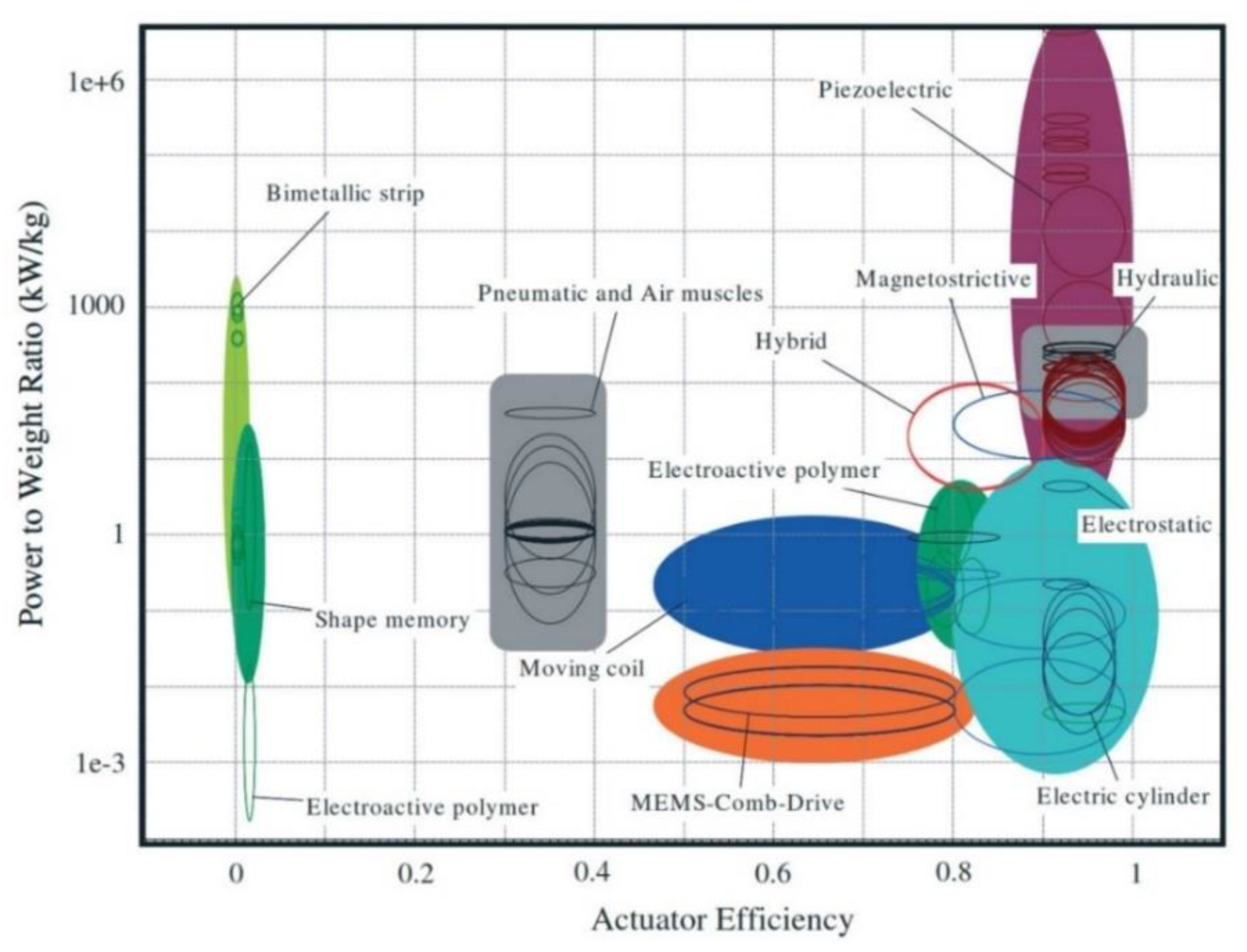
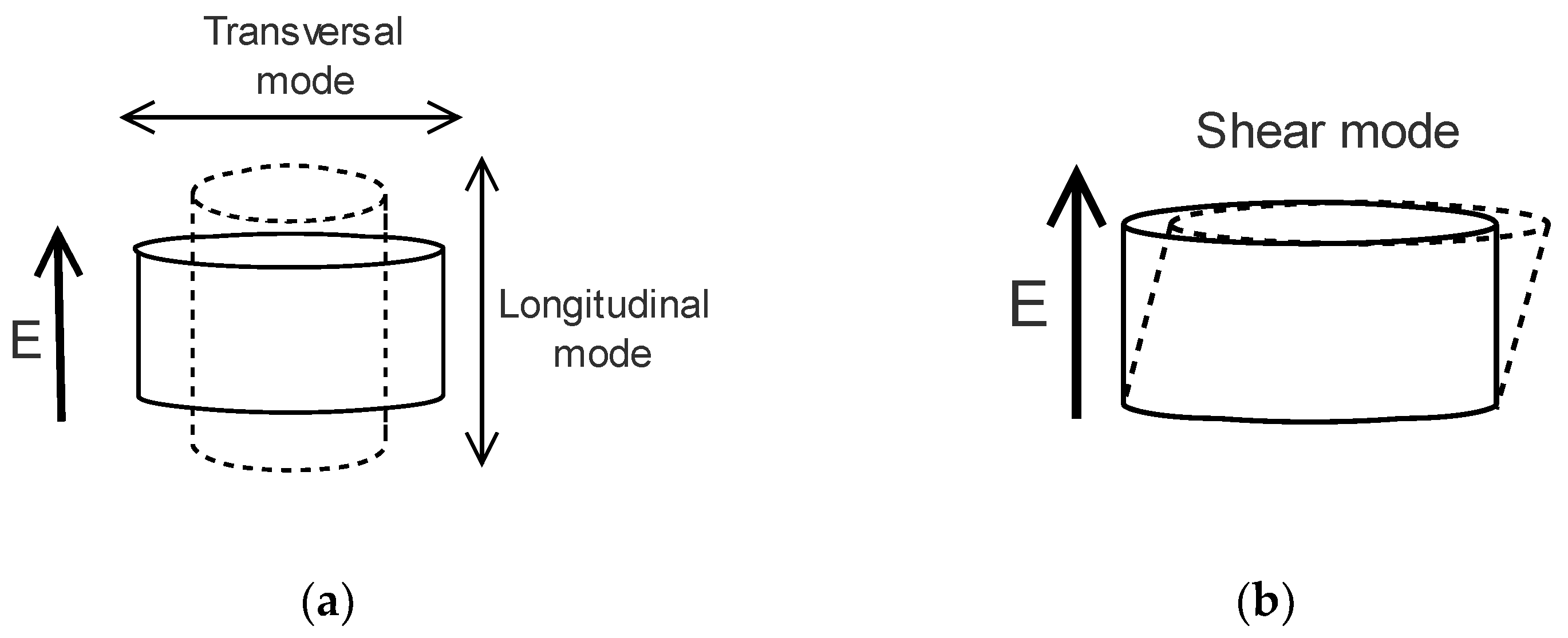
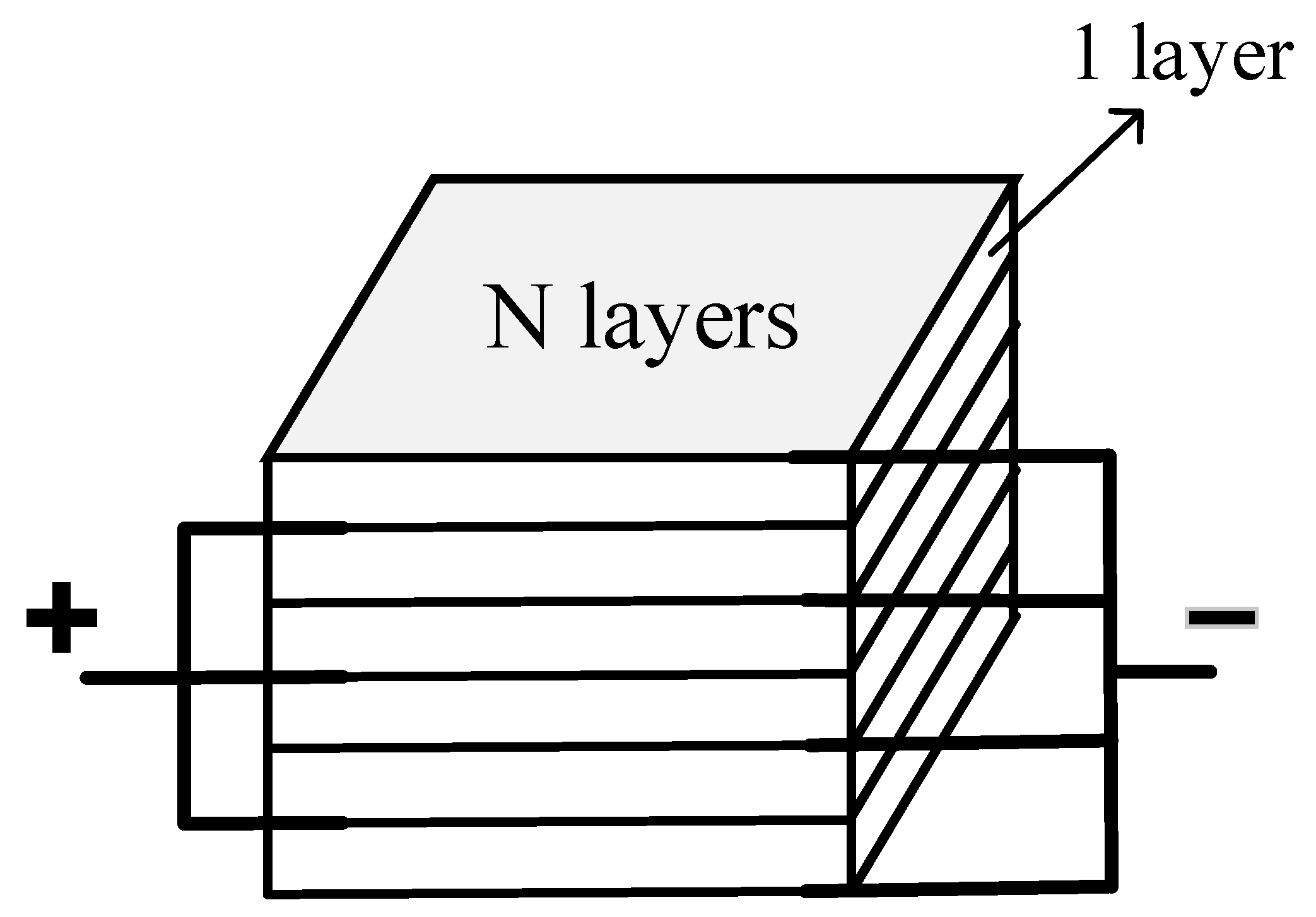
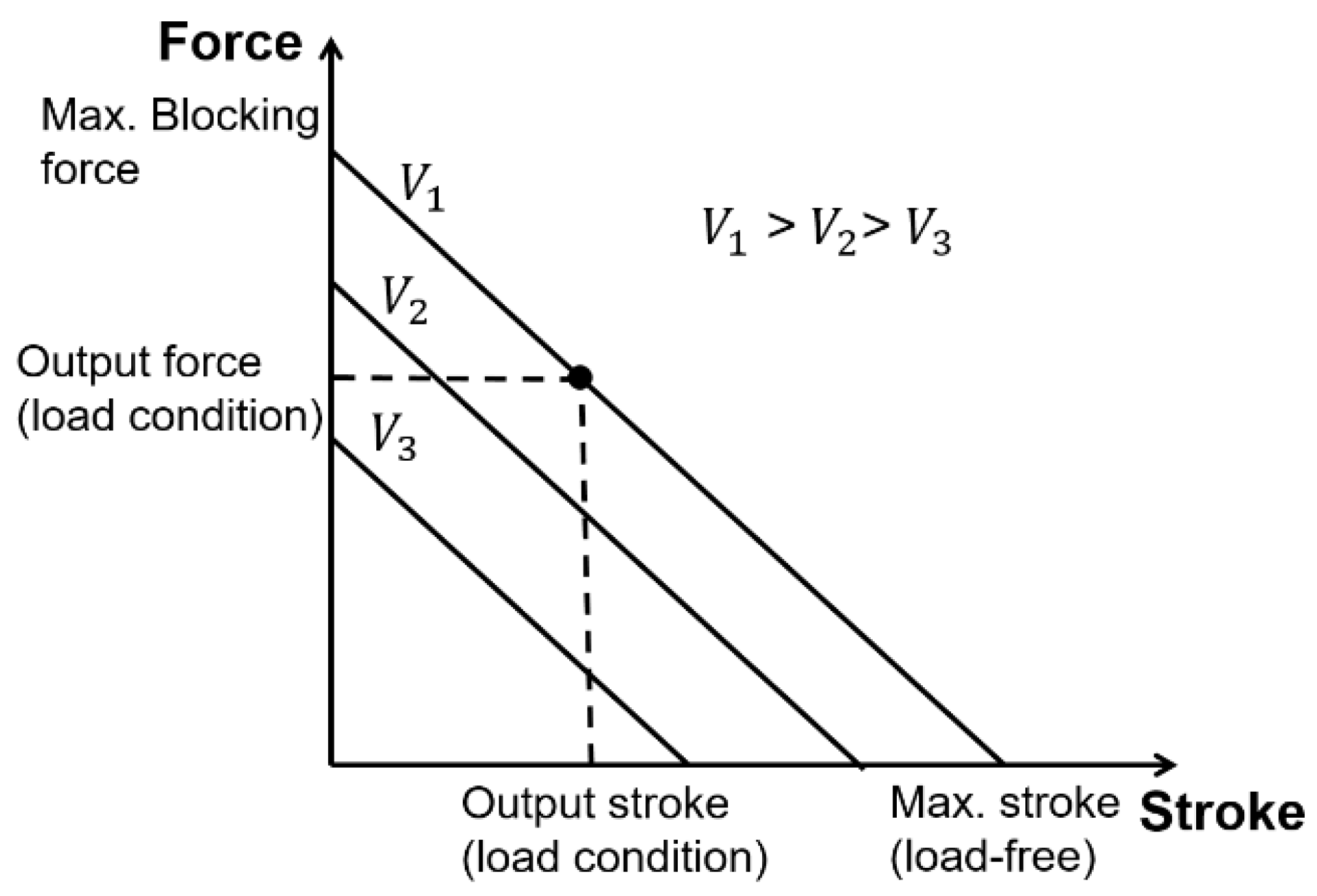




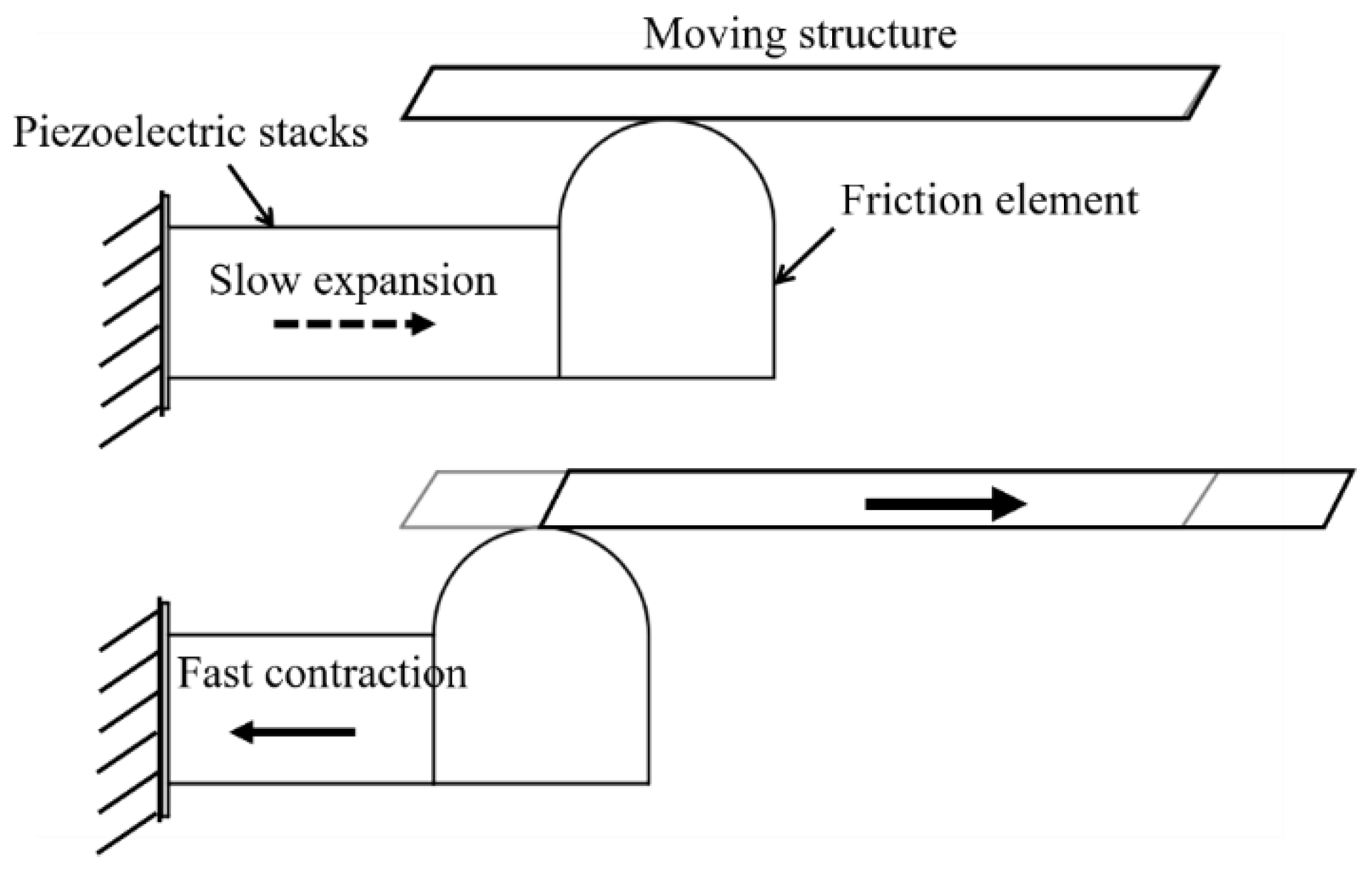
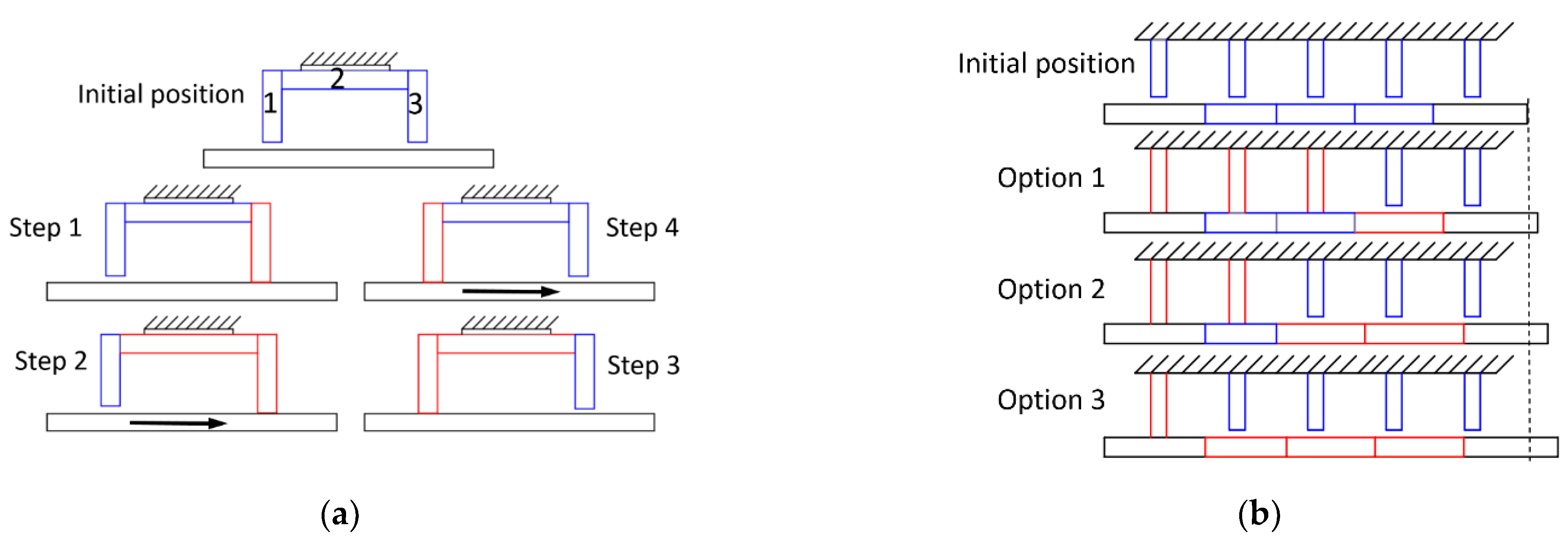



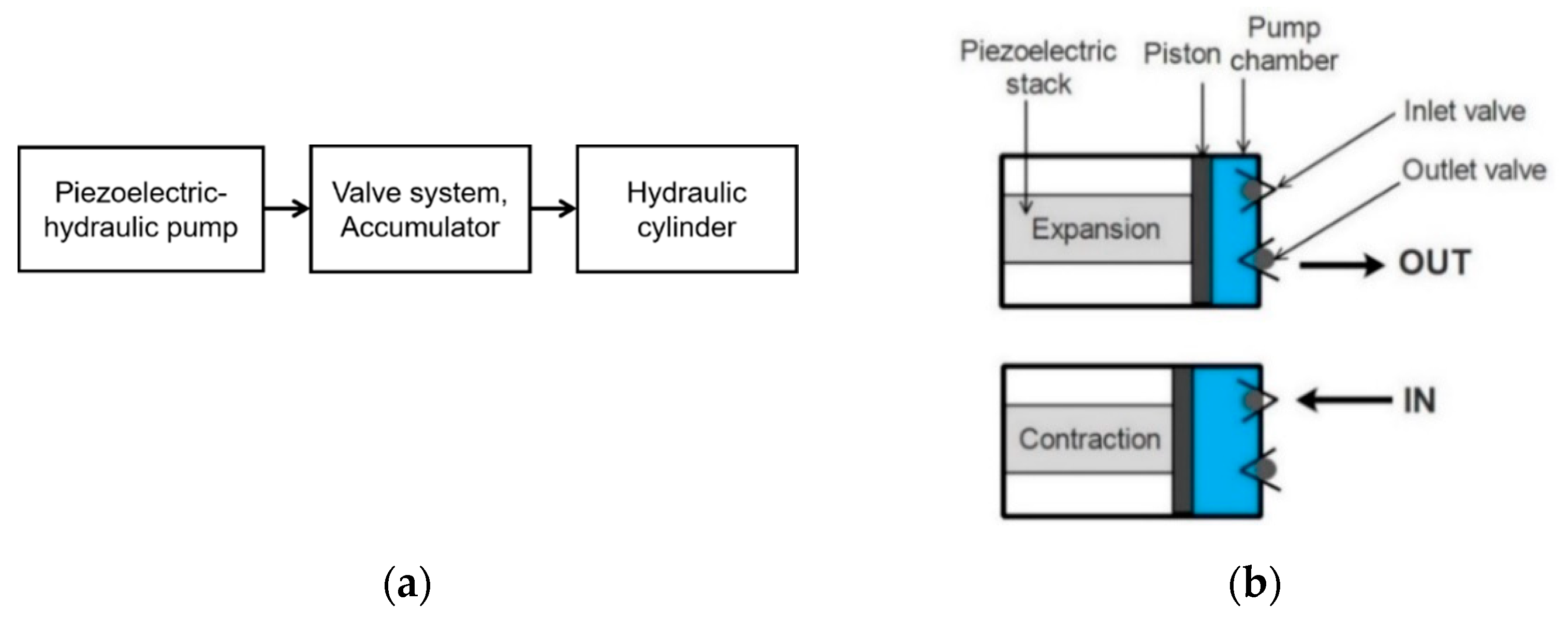


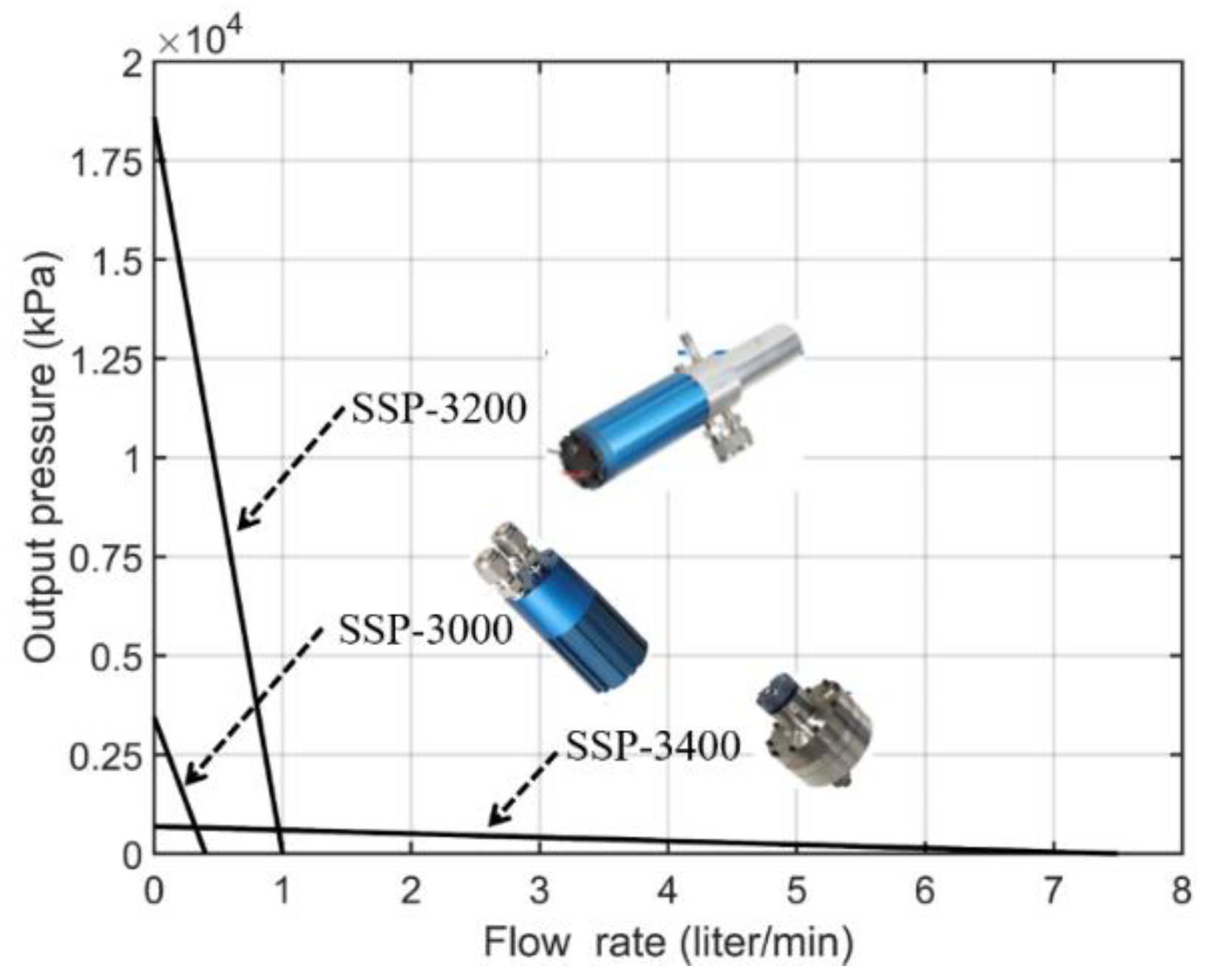
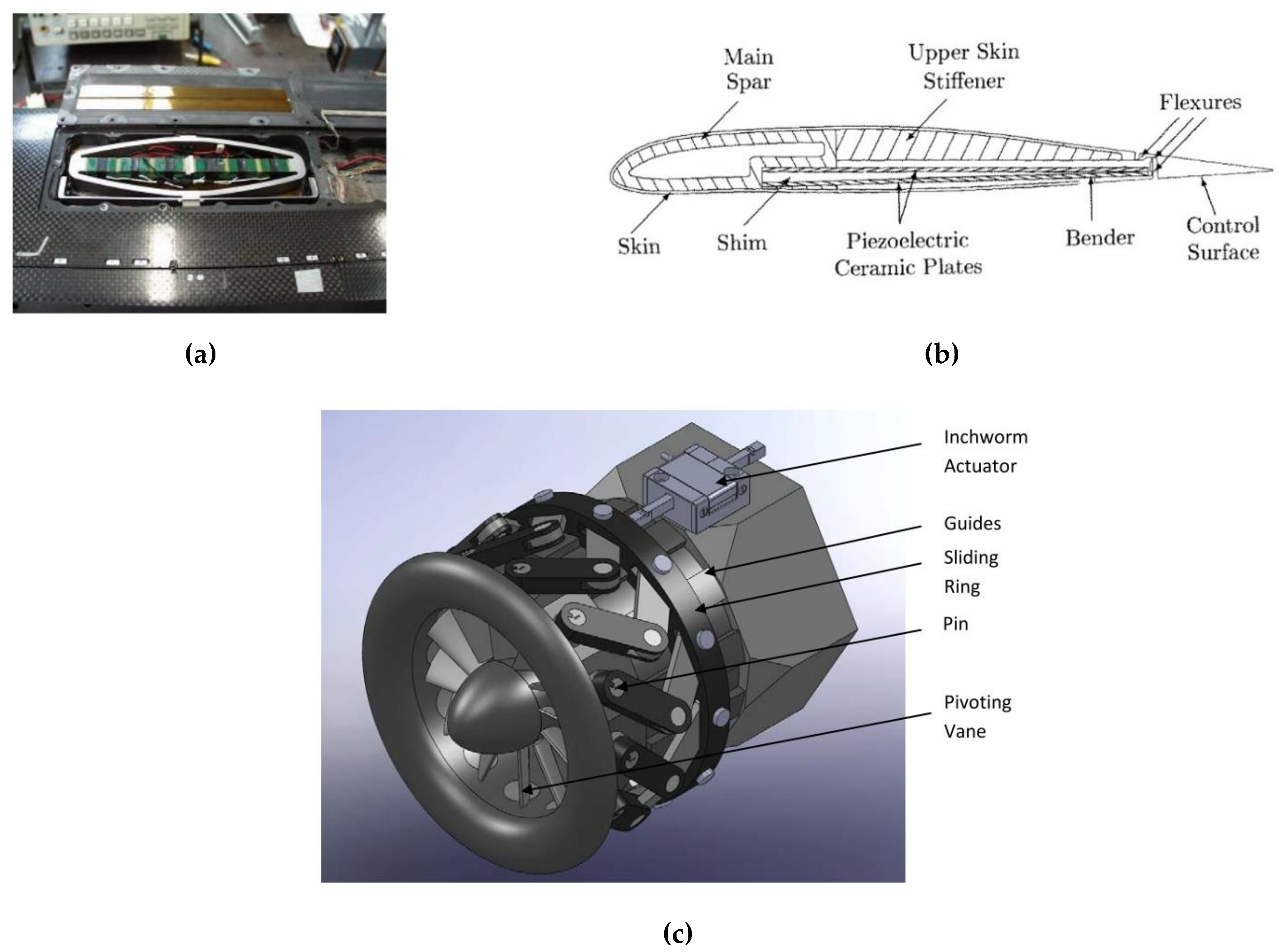
| Materials | at Room Temp. (pC/N) | Curie Temp. TC (°C) | Operating Temp. (°C) | Reference |
|---|---|---|---|---|
| PZT powder | 590–610 | - | - | [20] |
| PMN-PT | 2000–3500 | 120–130 | Up to 80 | [42,60] |
| PZN-PT | 1900–2000 | 160 | Up to 110 | [42,64] |
| PZT-5H | 585 | 170 | −150–125 | [44] |
| PZT Navy Type III (Hard) 1 | <300 | 305 | Up to 220 | [45] |
| PZT-4 | 225 | 310 | −150–100 | [44] |
| PZT Navy Type II (Soft) 2 | <600 | 340 | Up to 200 | [45] |
| PZT-5A | 350 | 350 | Up to 250 | [44] |
| PIC series | 240–500 | 160–370 | −40–150 | [65] |
| Lead-free materials | ||||
| BTBK | 58.9–117 | 170–223 | - | [56] |
| BNT | 91 | 320 | - | [56] |
| KNN | 80–160 | Up to 400 | - | [57] |
| High-temperature materials | ||||
| Pb(NbO3)2 | 81 | 550 | Up to 300 | [45] |
| Bi4Ti3O12 | 3.5 | 675 | Up to 675 | [45] |
| Bi4Ti2.86Nb0.14O12 | 20 | 655 | Up to 655 | [45] |
| Form | Typical Size | Displacement Range | Resonant Frequency |
|---|---|---|---|
| Single layer (wafer) | A few hundred micrometer thickness | ||
|
Multilayer
extension (rectangle, round, hollow stacks) | in length | and more | |
| Multilayer shear ing | length | and more | |
| Piezo bender (unimorph/bimorph) | <1 thickness | ||
|
Macrofiber composite (elongation) | active length | 1 | |
|
Macrofiber composite (contraction) | active length | 2 |
| Sinusoidal Waveform | Square/Rectangle Waveform | Sawtooth Waveform |
|---|---|---|
 |  |  |
| /4 |
| Flexure Hinge | Piezoelectric (mm) | Voltage (Vp-p) | Frequency (Hz) | Force (N) | Speed (mm/s) | Reference |
|---|---|---|---|---|---|---|
| Symmetrical (Z shaped) | (Two) | 100 | 5000 | 3.43 1 (1 Hz) | 6.057 | [105] |
| Symmetrical (bridge type) | (Two) | 100 | 1000 | 1.58 (1 Hz) | 7.95 | [104] |
| Asymmetrical (nonparallel type) | (One) | 100 | 500 | 2.94 * | 5.96 | [92] |
| Asymmetrical (parallelogram type) | (One) | 100 | 2000 | 3.43 | 14.25 | [107] |
| Asymmetrical (four-bar mechanism) | (One) | 100 | 490 | 4.32 | 15.04 | [93] |
| Configuration of the Piezoelectric Stack | Output Force | Speed | Resolution |
|---|---|---|---|
| Bending configuration (NEXACT) | ~10–20 N/50 g (20 mm travel range) | Medium Up to 10 mm/s | 0.03 nm (open loop) - |
| V-shape configuration (PICMAWalk) | ~50–60 N/700 g (20 mm travel range) | High Up to 15 mm/s | 0.02 nm (open loop) <10 nm (closed loop) |
| Combination of longitudinal and shear modes (NEXLINE) | Up to 600 N/1250 g (20 mm travel range) | Low Up to 1 mm/s | 0.03 nm (open loop) 5 nm (closed loop) |
| Fluid | Density (kg/m3) | Temperature Range (°C) | Bulk Modulus (GPa) | Viscosity | Reference | |
|---|---|---|---|---|---|---|
| 40 °C | 100 °C | |||||
| Water | 997 | 0–100 | 2.1 | 0.7 | 0.5 | [171] |
| 70% Glycerinaquerous | 1181 | −39–114 1 | 0.4 | 22.5 | - | [172] |
| Hydrolubric 123-B | - | ~1 (Pour point) | - | 21.5 3 | - | [173] |
| Mobile DTE-24 | 871 | −27–220 1 | 1.7 | 31.5 | 5.3 | [174] |
| AeroShell 41 | 874 | −41–135 2 | - | 15.68 | 6.13 | [175] |
| MIL-H5606F | 859 | −54–135 | 1.79 | 15 | - | [154] |
| IL-EMIM-EtSO4 | 1241 | 162 (Flash point) | 3.1 | 39.44 | 7.66 | [170] |
| Type | Pros. | Cons. |
|---|---|---|
| Reed valve | Simpler structure | Working frequency limitations |
| Microreed valve array | Small size and low inertia, hence a broader working frequency range | Complex structure and requirement of micromachining |
| Active valve (piezoelectric disc) | Operates at a higher frequency | Complex control |
| Diffuser valve—conical shape | No moving part, hence no fatigue failure | Leakage |
| Diffuser valve—Tesla valve | Lesser pressure drop | Complex structure |
| Piezo Stack (mm) | Voltage (Vp-p) | Frequency (Hz) | Valve | Pressure (kPa) | Flow Rate (mL/min) | Reference |
|---|---|---|---|---|---|---|
| 102 | 800 | 60 | Commercial ball-type check valve | 3800 | 312 | [141] |
| PZWT100 20 | 1000 | 1000 | Unimorph disc valve | 8300 | 204 | [165] |
36 | 120 | 60 | Reed valve | 7.96 | 10.32 | [169] |
| 81 | 100 | 200 | Reed valve | 550 | 1140 | [139] |
| 18 | 100 | 300 | Reed valve | 1600 | 180 | [154] |
| 18 | 150 | 400 | Reed valve | 125 | 186 | [167] |
30 | 150 | 400 | Reed valve | 1724 | 338 | [182] |
| 60 | 1000 | 300 | Reed valve (double piezo pump) | 6532 | 1246 | [163] |
| PZWT100 stroke) | 1200 | 1000 | Reed valve MEMS valve | 6895 | 1830 | [168] |
| Concept | Structure | Force | Stroke | Resolution | Speed | Control |
|---|---|---|---|---|---|---|
| Continuous motion | ||||||
| Flexure mechanism | Medium | Medium | Small | - | - | Simple |
| Lever, X-mechanism | Simple | Medium | Small | - | - | Simple |
| Bimorph configuration | Simple | Low | Very small | - | - | Simple |
| Quasi-static stepped motion | ||||||
| Inchworm—intermittent | Medium | Large | Large | Medium | Low | Complex |
| Inchworm—continuous | Medium | Medium | Large | Medium | Low | Complex |
| Inertial | Medium | Small | Large | High | Medium | Simple |
| Walking—bending legs | Complex | Small | Large | High | High | Medium |
| Walking—V-shape legs | Complex | Small | Large | High | High | Medium |
| Walking—combination legs | Complex | Medium | Large | High | Medium | Medium |
| Ultrasonic stepped motion | ||||||
| Standing wave | Medium | Small | Large | Medium | High | Medium |
| Traveling wave | Complex | Small | Large | Medium | High | Complex |
Publisher’s Note: MDPI stays neutral with regard to jurisdictional claims in published maps and institutional affiliations. |
© 2021 by the authors. Licensee MDPI, Basel, Switzerland. This article is an open access article distributed under the terms and conditions of the Creative Commons Attribution (CC BY) license (http://creativecommons.org/licenses/by/4.0/).
Share and Cite
Vo, T.V.K.; Lubecki, T.M.; Chow, W.T.; Gupta, A.; Li, K.H.H. Large-Scale Piezoelectric-Based Systems for More Electric Aircraft Applications. Micromachines 2021, 12, 140. https://doi.org/10.3390/mi12020140
Vo TVK, Lubecki TM, Chow WT, Gupta A, Li KHH. Large-Scale Piezoelectric-Based Systems for More Electric Aircraft Applications. Micromachines. 2021; 12(2):140. https://doi.org/10.3390/mi12020140
Chicago/Turabian StyleVo, Tran Vy Khanh, Tomasz Marek Lubecki, Wai Tuck Chow, Amit Gupta, and King Ho Holden Li. 2021. "Large-Scale Piezoelectric-Based Systems for More Electric Aircraft Applications" Micromachines 12, no. 2: 140. https://doi.org/10.3390/mi12020140
APA StyleVo, T. V. K., Lubecki, T. M., Chow, W. T., Gupta, A., & Li, K. H. H. (2021). Large-Scale Piezoelectric-Based Systems for More Electric Aircraft Applications. Micromachines, 12(2), 140. https://doi.org/10.3390/mi12020140







